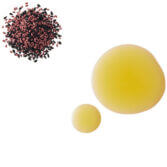Product Benefits
The Hydrating Oil Blend was formulated to promote moisture and provide antioxidant properties.
Hydrating Oil Blend is especially high in the Omega-9 fatty acid Oleic acid. This fatty acid is highly anti-inflammatory and has been demonstrated to mitigate the negative effects of excessive inflammation in several scientific models.1
Hydrating Oil Blend contains a significant amount of the Omega-3 fatty acid Alpha-Linolenic acid. The intake of Omega-3 fatty acids has been shown to trigger anti-inflammatory reactions via oxygenated metabolites that are products in the body after consumption.2
Hydrating Oil Blend contains a significant amount of the Omega-6 fatty acid Linoleic acid. This particular fatty acid has demonstrated remarkable benefits in wound healing and tissue repair when included in products for topical applications and may therefore show powerful benefits cosmetically for soothing and repairing inflamed or damaged skin.3
Hydrating Oil Blend contains carotenoids, a potent class of antioxidant molecules that can help protect the skin from the ever-present environmental threat of excessive oxidative stress.4
Hydrating Oil Blend is created from NatureFRESH™ cold-pressed seed oils and blended to leverage the wide array of phytonutrients contained in each oil.



